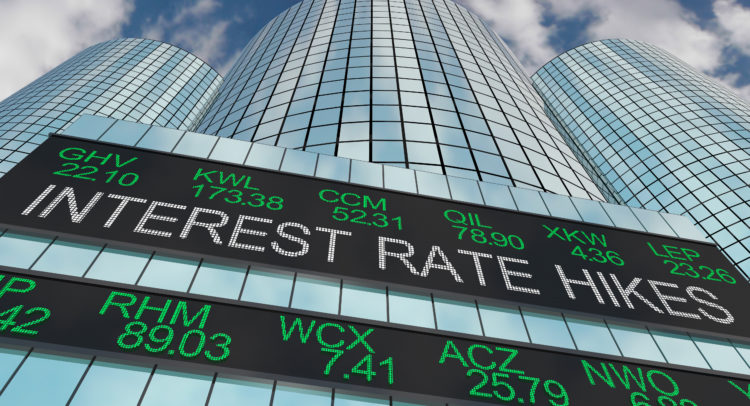First Published at 6:19AM EST
Claim 70% Off TipRanks This Holiday Season
- Unlock hedge fund-level data and powerful investing tools for smarter, sharper decisions
- Stay ahead of the market with the latest news and analysis and maximize your portfolio's potential
Stock indices finished today’s trading session in the red after the crucial FOMC meeting. The Dow Jones Industrial Average (DJIA), the S&P 500 (SPX), and the Nasdaq 100 (NDX) all fell by 1.7%, 1.71%, and 1.8%, respectively. Wednesday marked the last day of the Fed’s FOMC meeting, where the Fed announced a 75 basis-point rate hike. Although this was expected, forward projections for the Fed Funds rate came in higher than expected.
In June, the Federal Reserve had projected Fed Funds rates of 3.8% and 3.4% for 2023 and 2024, respectively. However, the updated projection now stands at 4.6% and 3.9%, respectively. In addition, its real GDP forecast for 2022 fell to 0.2%, compared to its June expectation of 1.7%.
As a result, the Two-Year Treasury yield topped 4% for the first time since 2007, as it currently hovers around 4.04%. Meanwhile, the 10-Year Treasury yield fell slightly to 3.51%. As a result, the spread between the two yields now stands at -53 basis points.
Unsurprisingly, the market is pricing in a higher chance of a higher Fed Funds rate for the end of the year. In fact, the market’s expectations for a rate in the range of 4% to 4.25% decreased to 34.1%, which is down from yesterday’s expectations of 39.2%. In addition, the market is now also assigning a 59.8% probability to a range of 4.25% to 4.5%. For reference, investors had assigned a 43.8% chance Tuesday.
In addition, WTI crude oil is down 1.14% and is now hovering at $83.30 a barrel despite Russia mobilizing its reservists. The positive Q1 showing by general Mills could buoy consumer names today as well.
Investors Must Wait It Out
The unexpectedly high inflation in August came as a shocker since most were expecting a 0.1% month-over-month decline, given a 5% drop in August’s oil prices. The August CPI reveal sent waves of panic among investors who started to speculate about a 100 basis-point hike in interest rates or even more.
The market appears to not have been prepared for today’s news, and uncertainty will keep the markets choppy until inflation shows signs of sustained cooling (maybe six to 12 months of deflation).
It is wise right now to maintain a longer-term view and consider value stocks that will most likely survive a downturn.
Mortgage Rates Continue to Rise as Existing Home Sales Fall
On Wednesday, the Mortgage Bankers Association released its weekly report for the U.S. 30-Year mortgage rate. The mortgage rate increased to 6.25% compared to last week’s reading of 6.01%.
Despite the higher rates, the number of mortgage applications increased week-over-week by 3.8%, following last week’s decrease of -1.2%. This might indicate that homebuyers might be expecting rates to climb significantly higher and are trying to lock in the current rate.
In addition, mortgage application volume is down substantially on a year-over-year basis, with the Mortgage Market Index at 264.7 compared to 742.7 on September 22, 2021.
Furthermore, the National Association of Realtors released its U.S. Existing Home Sales report, which measures the change in sales of existing residential buildings during the previous month on an annualized basis. Existing home sales came in at 4.8 million for the month of August, above the expected 4.7 million.
Nevertheless, this figure was the lowest reading since June 2020, as existing home sales declined from the previous month’s print of 4.82 million. Indeed, this represents the seventh straight month of declines, as higher interest rates continue to make homeownership difficult. On a year-over-year basis, sales fell 18.7%.
It is likely that this downward trend will continue as the Federal Reserve continues to hike interest rates to combat inflation.
What Happened on Tuesday
On Tuesday, the S&P 500, the Dow, and the Nasdaq 100 ended the regular trading session with losses of 1.13%, 1.01%, and 0.85%, respectively.
In the bond market, yields climbed in response to the dip in equities. The 2-year Treasury yield grew 3.99% first time in 15 years. During the day, the 10-year Treasury note yield touched an 11-year high of 3.6%.
Meanwhile, in the housing market, a higher-than-expected number of new house starts combined with the lowest recorded decline in building permits since April 2020 baffled the industry. The real estate sector closed 2.57% lower on Tuesday, accruing the largest losses among all the major sectors of the U.S. economy.
















